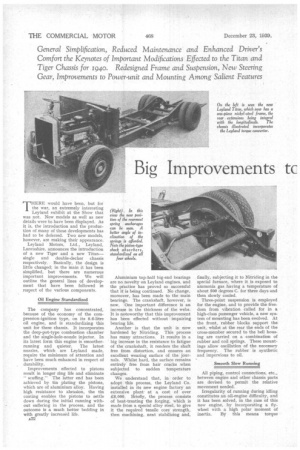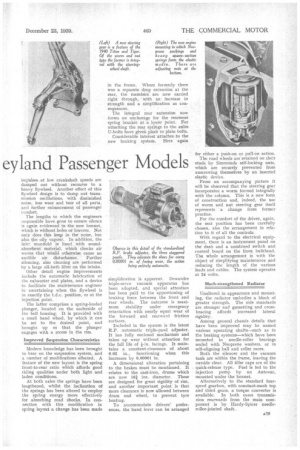Big Improvements tc eyland Passenger Models
Page 24

Page 25

If you've noticed an error in this article please click here to report it so we can fix it.
THERE would have been, but for the war, an extremely interesting Leyland exhibit at the Show that was not. New models as well as new details were to have been displayed. As it is, the introduction and the production of many of these developments has had to be deferred. Two new models, however, are making their appearance.
Leyland Motors, Ltd., Leyland, Lancashire, announces the introduction of a new Tiger and a new Titan— single and double-decker chassis respectively. Basically, the design is little changed; in the main it has been simplified, but there are numerous important improvements. We will outline the general lines of development that have been followed in respect of the various components, Oil Engine Standardized The company has concentrated, because of the economy of the cornpression-ignition type, on its 8.6-litre oil engine, and is standardizing this unit for these chassis. It incorporates the deep-pot-type combustion chamber and the single-hole-nozzle injector. In its latest form this engine is smootherrunning and quieter. The latest nozzles, which are Leyland made, require the minimum of attention and have been much enhanced in respect of durability.
Improvements effected to pistons result in longer ring life and eliminate " scuffing." The latter end has been achieved by tin plating the pistons, which are of aluminium alloy. Having high resistance to abrasion, the tin coating enables the pistons to settle down during the initial running without suffering in the process, and the outcome is a much better bedding in with greatly increased life.
a22 Aluminium top-half big-end bearings are no novelty on Leyland engines, and the practice has proved so successful that it is being continued. No change, moreover, has been made to the main bearings. The crankshaft, however, is new. One important difference is an increase in the thickness of the webs. It is noteworthy that this improvement has been effected without impairing bearing life.
Another is that the unit is now hardened by Nitriding. This process has many attractions. It results in a big increase in the resistance to fatigue of the crankshaft, it renders the shaft free from distortion, and ensures an excellent wearing surface of the journals. Whilst hard, the surface remains entirely free from hair cracks when subjected to sudden temperature changes.
We understand that, in order to adopt this process, the Leyland Co. installed in its new engine factory an extensive plant at a cost of over £8,000. Briefly, the process consists of heat-treating the forging, which is made from a special alloy steel, to give it the required tensile core strength, then machining, next stabilizing and, finally, subjecting it to Nitriding in the special furnace, where it is exposed to ammonia gas having a temperature of about 500 degrees C. for three days and then slowly cooled.
Three-point suspension is employed for the engine, and to provide the freedom from vibration called for in a high-class passenger vehicle, a new system of mounting has been evolved. At the front, rubber blocks support the unit, whilst at the rear the ends of the cross-member secured to the bell housing are carried on a combination of rubber and coil springs. These mountings allow oscillation of the necessary frequency. The rubber is synthetic and impervious to oil.
Smooth Slow Running All piping, control connections, etc., between engine and other chassis parts are devised to permit the relative movement needed.
Irregularity of running during idling constitutes an oil-engine difficulty, and it has been solved, in the case of this new engine, by incorporating a flywheel with a high polar moment of inertia. By this means torque imPulses at low crankshaft speeds are damped out without recourse to a heavy flywheel. Another effect of this flywheel design is to damp out transmission oscillations, with diminished noise, less wear and tear of all parts, and further enhancement of passenger comfort.
The lengths to which the engineers ;responsible have gone to ensure silence is again evidenced in the new bonnet, which is without holes or louvres. Not only does this kee,,p in the noise, but also the oily vapour. In addition, the inlet: manifold is lined with soundabsorbent material, which checks air waves that would otherwise cause an audible air disturbance. Further silencing, also cleaning are performed by a large oil-bath filter on the intake.
Other detail engine improvements include the automatic lubrication of the exhauster end plates, and a device to facilitate the maintenance engineer in ascertaining when the flywheel is in exactly the t.d.c. position, or at the injection point.
The latter comprises a spring-loaded plunger, located on the underside of the bell housing. It is provided with a small hand wheel, by which it can be set to the desired point, and brought up so that the plunger engages with a recess in the rim.
Improved Suspension Characteristics Modern knowledge has been brought to bear on the suspension system, and a number of modifications effected. A feature of the new layout is the spring front-to-rear ratio which aflords good riding qualities under both light and laden conditions.
At both axles the springs have been lengthened, whilst the inclination of the springs has been altered to employ the spring energy more effectively for absorbing road shocks. In connection with this modification in spring layout a change has been made in the frame. Where formerly there was a separate drop extension at the rear, the members are now carried right through, with a,n increase in strength and a simplification as consequences.
The integral rear extension now forms an anchorage for the rearmost spring bracket at a lower point. For attaching the rear springs to the axles U-bolts have given place to plain bolts.
Considerable interest attaches to the new braking system. Here again simplification is apparent. Dewandre triple-servo vacuum apparatus has been adopted, and special attention has been paid to the apportioning of braking force between the front and rear wheels. The outcome is maximum stability under emergency retardation with nearly equal wear of the forward and rearward friction surfaces.
Included in the system is the latest R.P. automatic triple-pawl adjuster_ It has fully enclosed mechanism and takes up wear without attention for the full life of i-in. facings. It maintains a constant-clearance of about 0.02 in., functioning when this increases by 0.00001 in.
A dimensional alteration pertaining to the brakes must be mentioned. It relates to the cast-iron, drums which are now 161 ins. diameter. These are designed for great rigidity of rim, and another important point is that more clearance is now allowed between drum and wheel, to prevent tyre heating.
To accommodate drivers' preferences, the hand lever can be arranged for either a push-on or pull-on action.
The road wheels are retained on their studs by Sirnmonds self-locking nuts, which are securely prevented from unscrewing themselves by an inserted elastic device.
From an accompanying picture it will be observed that the steering gear incorporates a worm formed integrally with the column. This is a new form of construction and, indeed, the use of worm and nut steering gear itself represents ' a change from former practice.
For the comfort of the driver, again, the seat position has been carefully chosen, also the arrangement in relation to it of all the controls.
With regard to the electrical equipment, there is an instrument panel on the dash and a combined switch and control board on the front bulkhead. The whole arrangement is with the object of simplifying maintenance and reducing the length of the various leads and cables. The system operates at 24 volts.
Much•strengthened Radiator Unaltered in appearance and mounting, the radiator embodies a block of greater strength. The side standards are stronger and gussetting and crossbracing affords increased lateral Among general chassis details that have been improved may be named various operating shafts—such as in the braking systems—which have been mounted in needle-roller bearings sealed with Neoprene washers, or in self-aligning ball and roller races.
Both the silencer and the vacuum tank are within the frame, leaving, the outside clear. All filler caps are of the quick-release type. Fuel is fed to the injection pump by an Autovac, mounted under the bonnet.
Alternatively to the standard fourspeed gearbox, with constant-mesh top and third gears, a torque converter is available. In both cases transmission rearwards from the main component is by Hardy-Spicer needleroller-jointed shaft.




















































